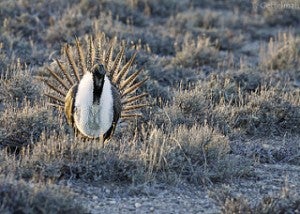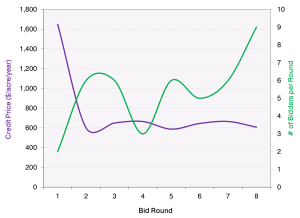Nevada landowners eager to generate conservation credits, help sage-grouse
 The state of Nevada recently made $1 million available to landowners for enhancing and restoring habitat for the greater sage-grouse, with another $1 million becoming available in the fall of 2016.
The state of Nevada recently made $1 million available to landowners for enhancing and restoring habitat for the greater sage-grouse, with another $1 million becoming available in the fall of 2016.
Nearly two dozen landowners submitted letters of interest to generate conservation credits for the bird – a clear signal that the market for conservation is viable and competitive.
The U.S. Fish and Wildlife Service may have determined that listing the greater sage-grouse on the Endangered Species List was “not warranted,” but that isn’t stopping landowners in key states from stepping up to help the bird, ensuring that it stays off the list. That’s because new conservation programs are coming online that are attractive to landowners, conservationists, and state and federal agencies.
An innovative, appealing approach
The Nevada Conservation Credit System is one such program that allows landowners to get paid for effective, long-term conservation activities. The $1 million made available by the state of Nevada will provide seed funding for this emerging market – funds that are to be paid back to the state upon credit sale, once landowners sell them to impact industries seeking mitigation.
By offering this seed funding and requiring repayment at the time of credit sale, the state is giving a boost to the developing credit market in Nevada and reducing the financial risk to landowners.
Once the state recovers its investment, funds will be reinvested in additional conservation projects using the same process.
Nevada is the first to take steps towards implementing a state-supported mitigation stewardship fund. This is a landmark step towards establishing long-term mitigation and conservation programs for the sage-grouse.
Paying for success

To ensure the highest environmental outcomes per dollar invested, the state is using a reverse auction approach to select which landowners receive funding.
Further, the state is piloting a new “pay for success” model that incentivizes landowners, who are in the best position to influence the outcomes of conservation projects, to maximize the state’s conservation investment. This model takes into account the quality and scale of improvements to the habitat, as well as additionality and durability requirements of the Nevada Conservation Credit System.
Building momentum on the ground
In addition to landowner interest in the Nevada Conservation Credit System, USDA’s Regional Conservation Partnership Program just announced funding for various conservation projects, which include a proposal submitted by Colorado and Nevada to help producers generate greater outcomes for greater sage-grouse.
The funding will provide $1.9 million more to invest in conservation projects on private rangelands – a major milestone and exciting example of the power of cooperative conservation and market-based approaches. Nevada is planning to leverage a reverse auction to distribute these funds as well, putting tangible projects on the ground, in the best locations for sage-grouse, fast.
We must continue to build on the momentum created by the state of Nevada and USDA, increasing investments in approaches that tap into working lands and drive more landowners to become a part of the conservation solution.
Related:
$2 million available for Nevada landowners to earn revenue through sage-grouse pilots >>
What’s next for the greater sage-grouse? A public lands strategy >>
Operation Warbler: Fort Hood and local ranchers team up to save bird >>












